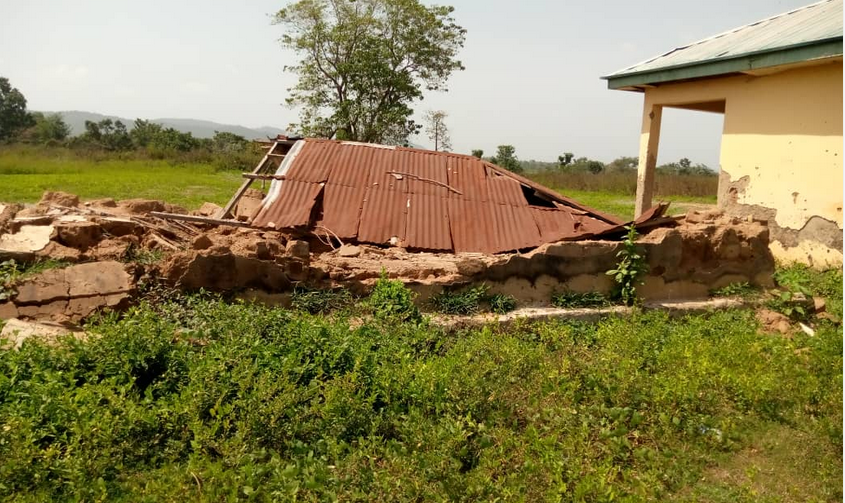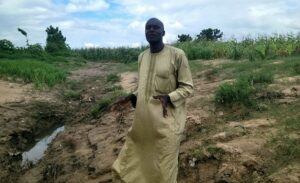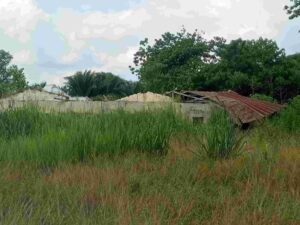Their plea demands more than attention; it needs a firm commitment to accountability and a renewed vision for an education system that lifts up every child, regardless of their background or circumstance.
In 1991, the residents of Gawu, a community in the Kuje Area Council of the Federal Capital Territory (FCT), took the initiative to establish a primary school. Their only drive was the desire to educate their children. Despite the absence of any existing structures, the determined community pressed on. They found shelter at the ECWA Church building at the heart of the community, making the commencement of learning possible. And thus, Gawu Local Education Authority (LEA) Primary School was birthed.
Three years later, the community achieved a significant milestone. They successfully constructed a simple yet functional mud-brick three-classroom block on the designated school site, relocating their children there.
For over 18 years, some of the pupils and teachers who had no space available for them within the classroom block persevered, conducting lessons beneath the shade of a tree. The endurance of this stopgap situation finally saw a positive turn when, in response to the persistent pleas of the community, the government, through the FCT Universal Basic Education Board (UBEB), took action in 2010 by constructing an additional block of three classrooms.
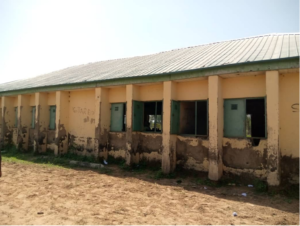 The classroom block built by the government
The classroom block built by the government
This little beginning, a makeshift haven became the cradle of hope, nurturing a generation eager to learn. Markus Japheth, one of the first pupils, vividly remembers those early days.
“In the beginning, some of us learned on the floor, because it took a while before the community arranged for seats. But none of that bothered us; we were just eager to learn,” Japheth recounts.
Now, the school, built on hope, is crumbling under systemic neglect. The Safer-Media Initiative’s (SMI) team visited the school and can confirm the collapse of the mud house, with the single three-classroom block built by FCT-UBEB in 2010 standing beside it. Another mud classrooms under construction were without doors and windows. Construction is even halted due to a lack of funds.
Inside the classrooms, the story is no better—broken furniture forces four or five pupils to share a single seat; their discomfort is amplified by the dusty floors and stifling heat radiating from the roof without ceiling. The teachers are too few in number, juggle multiple classes, and contend with a lack of basic resources.
In the staff room, the few teaching aids and textbooks were placed on the floor, as there was no cabinet to store them. On the wall were pictures of the various teachers who had taught at the school. The absence of gender diversity among the teaching staff could not go unnoticed. The SMI team observed that the school has never had a female teacher since its inception.
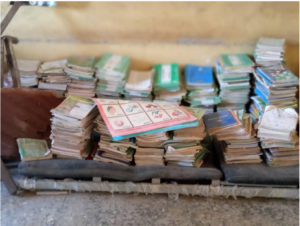 Classroom turned staff room, with books on the floor
Classroom turned staff room, with books on the floor
The SMI team also observed a toilet that the FCT MDGs/CDS project built for the school in 2009. It was seen in a bushy area, a short distance from the main facility. However, the teachers revealed that the toilet had never been used, even for a day, due to a lack of water. From an external view, the toilet has deteriorated due to non-usage.

The toilet facility that was never used
Additionally, a scaffold intended to support a water tank was noticed in the vicinity, but residents explained that the borehole, constructed during the MDGs project to supply water in the area, did not function. This unfortunate reality adds to the challenges faced by the school in providing essentials for its students and staff.
Japheth, now a teacher in the school, questioned if Gawu’s pupils would ever break free from this education limbo of uncertainty. But the answer to his question lies in the hearts of those with the power to transform their dreams into reality.
For him, each collapsed classroom and each broken chair represents a stolen opportunity, a dream deferred. He thinks that their plight demands a response, a commitment to accountability, and a renewed vision for an education system that lifts up every child, regardless of their background or circumstance.
Reflecting on the past and drawing connections to the present, Japheth recalled the community’s deep relief when the government stepped in to provide the classroom block in 2010.
“At that time, the children were divided between the new classroom block and the mud classrooms,” he recalled.
However, their happiness was short-lived as the mud classrooms became uninhabitable. Concerns about a potential collapse prompted the school management to relocate students who couldn’t fit into the government-built classrooms back under the tree.
“As we feared, two of the classrooms in the mud block collapsed during a rainy day. Thankfully, no one was present when it happened,” Japheth recounted.
Despite the challenges, the teachers opted not to entirely abandon the remaining part of the mud building, a single classroom. This space was repurposed as a staff room where teaching aids were stored. However, there were consequences to this.
“It wasn’t easy for us. We grappled with lizards and other crawling animals. You could be at your desk working, and suddenly, a lizard would just fall onto your desk from the roof without warning, sending shivers down your spine. We’d then start chasing the animal around to maintain order, all the while anticipating the fall of another lizard,” Japheth narrated.
However, at the beginning of this year, the staff room also collapsed. While the community has initiated the construction of another mud classroom block, there remains uncertainty about when the school will transform into a comfortable learning environment for their children.
Japheth, who serves as both a teacher and the community’s secretary, disclosed that the residents invested over N600,000 in building the mud classrooms. The funding was primarily generated through a communal practice known as ‘Godogo,’ in his dialect, translating to community farming.
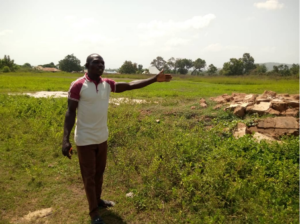 Mr. Japheth
Mr. Japheth
This practice involves all men in the community joining forces to farm for a member in exchange for funds saved in the community’s treasury. The farming duties rotate among community members, each contributing a predetermined amount, with the average being N12,000.
Japheth explained: “We take Godogo seriously. The Chief imposes a fine on anyone failing to participate when the farming is scheduled, and the fine is N5,000. Non-compliance with the rules might lead the Chief to involve the police, resulting in additional charges on top of the fine”
The 41-year-old father of three emphasised that the teachers, all native to the community, individually contributed N30,000 from their salaries to support the project. This contribution, however, was spread over a period rather than a lump sum.
Unfortunately, the construction has come to a halt due to insufficient funds, leaving the classrooms in an unfit state for learning.
Japheth explained: “The building has been erected, but we lack the funds to floor it, resulting in dusty floors. The walls are yet to be cemented, and we’ve only managed to buy cement for the construction of chalkboards. There are no windows, and the seats are broken.”
 The new classroom under construction
The new classroom under construction
With a student population of 206, even with the addition of the incomplete mud building, the classrooms remain insufficient. A temporary shade behind the government-built block now serves as a classroom for Early Childhood Care Development and Education (ECCDE) pupils.
“The temporary shade was initially used as a storeroom during the Home Grown Feeding Programme (HGFP), which was later suspended. Now, we use it to accommodate Nursery 1 and 2 pupils. One of the classrooms in the government-built block serves as our staff room, while the other two are for primary 5 and 6 pupils. The mud structure caters to the Primary 3 and 4 pupils,” Japheth clarified.
“The building is not conducive. We lack proper seating arrangements. In the makeshift shade, children sit on the ground. One seat accommodates four or five pupils, leaving them with minimal space,” he elaborated.
Japheth highlighted that the inadequate infrastructure and shortage of seats have significantly impacted the students’ learning experience. The cramped environment not only makes the surroundings uncomfortable but also results in frequent distractions among the pupils.
 Pupils sitting on broken seats
Pupils sitting on broken seats
“During lessons, the children easily distract each other due to the close seating arrangement. The teacher often has to pause teaching to restore calm before continuing. This leads to a considerable amount of time being wasted that could have been utilised for teaching,” he explained.
Furthermore, the school grapples with a lack of teachers and teaching materials. Currently, it has four male teachers, one female staff member serving as a clerk, and a male volunteer teacher who was formerly a student at the school.
“I handle two classes, teaching Primary 3 and 5. The other teachers manage the remaining classes. I devised a timetable to manage the teaching workload. It’s challenging, but we are doing our best to provide the children with a quality education,” Japheth remarked.
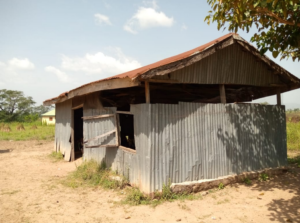 The nursery classroom
The nursery classroom
A story of disappointment from another ex-student
Solomon Gushara, a former student who graduated in 2012, shared a tale of disappointment as he witnessed the enduring challenges of his alma mater 11 years later. He has now received a National Certificate in Education (NCE). He found it disheartening that the issues he faced as a student persisted.
Recalling the hardships during his time, Gushara, who served as an assistant head boy, said: “We faced a lot of challenges. The heat made us uncomfortable, and there weren’t enough seats. Many students had to sit on the floor.”
Motivated by a deep sense of community belonging, Gushara, now 22, volunteered to teach in the school, driven by a desire to alleviate the struggles faced by the teachers. He emphasised the significance of quality basic education and expressed his wish for an improved educational environment at his alma mater, envisioning a brighter future for the current students.
Reflecting on his own journey, he revealed: “The challenges in this school, which I experienced, affected the way I relate to my peers during my tertiary education days, but I was still able to catch up, by God’s grace.”
Gushara expressed sorrow over the apparent decline of the school, noting that instead of progressing, it has regrettably continued to depreciate in standard.
Unhappy parents
Hannatu Samuel, a 30-year-old mother of two, voiced her concerns, highlighting the challenges her children faced sitting on the floor, resulting in them returning home dirty. She emphasised the financial burden of regularly washing their school uniforms, as she needs to buy water and soap.
Expressing the urgent need for government intervention, she remarked: “You see how the floors are. It is all dusty because it hasn’t been cemented. We need help from the government to create a conducive place for learning for our children.”
Despite the challenges, Hanatu, a farmer, commended the teachers for their dedication to their work at the school. She added that although she enrolled her children in the school because she had no other options, the teachers’ hard work in providing quality education was a source of consolation for the parents.
In LEA Gadoro
SMI also visited LEA Gadoro in another neighboring community. At Gadoro, the two classroom blocks built by the government in the 1980s still stand. The structures are, however, plagued by deteriorating ceilings and leaking roofs.
 LEA Gadoro
LEA Gadoro
Alhassan Shaibu, a local resident, emphasised the impact on students, particularly during the rainy season, when leaks disrupt the learning environment.
He expressed urgency, stating: “When it rains, the classrooms become unconducive for the children’s learning. The roof was changed years ago, but it has gone bad again. We need urgent intervention before the rains start again.”
Shaibu further highlighted the issue of broken seats in the school, necessitating four to five children to share a seat intended for two. This additional challenge compounds the need for prompt intervention to address the school’s infrastructure issues.
An appeal for assistance from the government met with silence, the blame game continues
The two communities have expressed their frustration, stating that they have written multiple letters to the FCT Universal Basic Education Board (FCT-UBEB) through the area council but have received no responses.
The Universal Basic Education Commission (UBEC) is a federal government agency responsible for coordinating all aspects of the Universal Basic Education (UBE) programme implementation. Meanwhile, The FCT-UBEB was established to manage early child learning centre s, primary schools, nomadic schools, special needs schools, and junior secondary schools in the FCT.
The Board among other things, also recruits, appoints, posts, deploys, promotes, and disciplines teaching and non-teaching staff of the FCT.
It also has the responsibility of disbursing funds provided by the UBEC and Federal Capital Territory Administration (FCTA) to local education authority (LEA) schools and communities, including providing an enabling environment for students in the territory.
As these communities blame the FCT and UBEB for the lack of response, the board cites limited resources and community initiatives as significant challenges. Unfortunately, the ultimate victims in this ongoing struggle are the children, who are being denied their fundamental right to a quality education.
UNICEF paints a bleak picture
According to UNICEF, limited infrastructure, insufficient supply of teachers, and limited learning data, especially on proficiency level, are some of the factors accounting for poor learning among children.
The international organisation said that three out of four children in Nigeria cannot read meaningfully or solve simple mathematical problems.
Experts like Chuks Ochei of Crystal Education Media emphasised the detrimental impact of such deficits, arguing for a more proactive approach, including a prototype agency like TETFund dedicated to basic education.
FCT-UBEB responds
SMI contacted Dr. Hassan Sule, the FCT UBEB chair, regarding its findings. He attributed overstretched facilities in the capital territory to insecurity and population influx. Sule acknowledged challenges in the education sector but rather emphasised that education is a collective responsibility for all Nigerians.
He acknowledged the existence of community-initiated schools in the FCT, starting independently before seeking board approval. He assured ongoing efforts to integrate these schools into the system and address their needs.
Explaining the process, Sule stated: “They usually contact us through the LEA and Area Councils, and we will come and check if they have the needed facilities like classrooms and land. We will then approve, and the government will intervene and support them according to their needs.”
He showed documents indicating the board’s acknowledgment of challenges and a pledge to address schools’ requirements. Notably, Gawu LEA School in Kuje Area Council was identified for the provision of blocks of classrooms.
In May 2023, UBEC reported that state governments failed to access over ₦46.2 billion in grants for public primary and junior secondary school development. However, Dr. Sule asserted that the FCT-UBEB, under his leadership, continues to access counterpart funding and utilises it effectively. Sule said he has established a committee to inspect schools across the FCT by January, aiming to implement an action plan.
Sule, however, fell short of providing a concrete timeline for the anticipated transformation resulting from his “ongoing efforts to integrate these schools into the system and address their needs.” Furthermore, there was no clarity on whether LEA Gawu, which has existed for over 32 years, hasn’t been integrated into the system yet.
This report is produced by Safer-Media Initiative under The Collaborative Media Engagement for Development, Inclusivity and Accountability Project (C-MEDIA Project) of the Wole Soyinka Centre for Investigative Journalism (WSCIJ) funded by the MacArthur Foundation.

